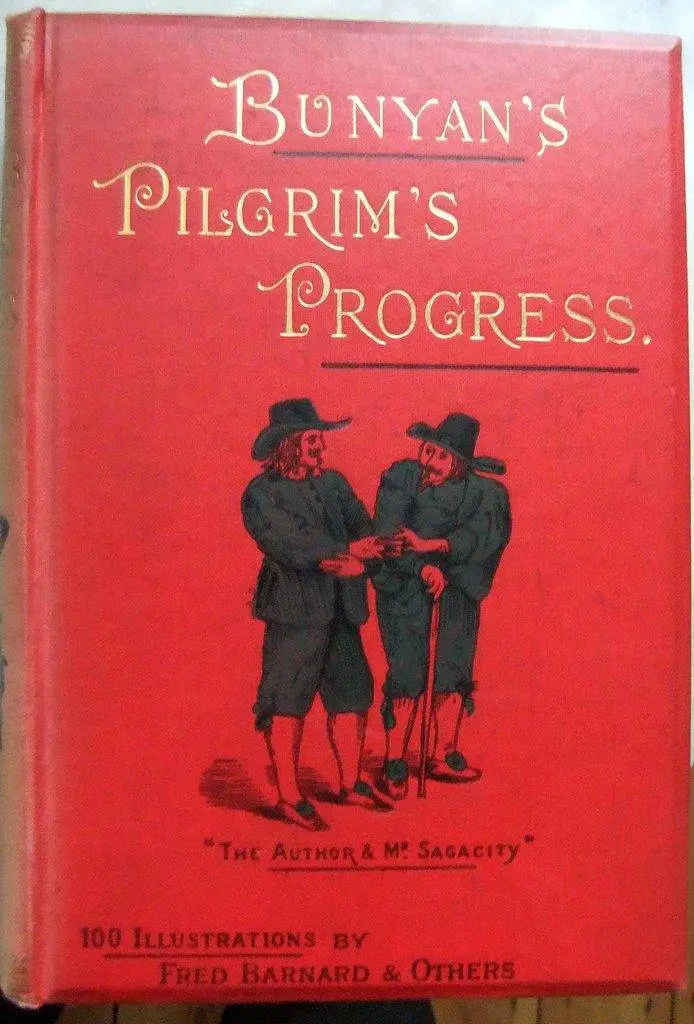Published in 1678, The Pilgrim’s Progress by English author John Bunyan is regarded as one of the most significant works of religious English literature. Presented as a dream narrative, it allegorically chronicles the spiritual journey of a man named Christian towards salvation. Beset by trials, moral dilemmas and vanities, he perseveres to reach the Celestial City. With its imaginative religious symbolism and emphasis on inner spiritual struggles, The Pilgrim’s Progress played a key role in popularizing the allegorical novel.
Table of Contents
Plot Summary
Burdened by sin, Christian flees doomed city Destruction and strives to reach the Celestial City. On his pilgrimage, he overcomes threats like the Slough of Despond, temptations like Vanity Fair, and villains like Giant Despair. Aided by figures like Evangelist, Help and Hopeful, he stays on the narrow path.
Christian finally crosses the river of death and is welcomed into heaven. In Part Two, his wife Christiana and their children also undertake the redemptive journey with similar struggles. Despite traps and diversions, they remain devoted and ultimately reunited with Christian.
Themes and Analysis
Major themes and ideas explored in this allegory are:
- Journey of spiritual redemption and perseverance through hardship
- Trials of maintaining Christian faith against world’s enticements
- Critique of religious establishments that have strayed from truth
- Hypocrisy of those who claim faith but live sinfully
- Deceptive nature of earthly pleasures, ambitions and knowledge
- Strength gained through Christian friendship and family
- Death as transition from living realm to divine eternal life
Using archetypal characters and locations modeled on Bible teachings, Bunyan depicts the inner battle between faith and doubt. While partly autobiographical, the allegorical form makes it universally accessible.
Bunyan refused to make Christianity seem easy and painted vivid moral dilemmas. The text combines harrowing drama with tender emotion, conveying spiritual guardianship. It engaged readers directly with colloquial eloquence and fervent imagery.
John Bunyan and Puritanism
John Bunyan was a travelling tinsmith in 17th century England who became a prominent Puritan Baptist preacher. Imprisoned for defying Stuart religious policies, he began writing allegories conveying his spiritual beliefs.

Relevant historical context includes:
- Ascendancy of Protestantism but clashes with Catholicism and Anglicans
- Religious persecution of dissenting minorities like Puritans
- Puritan values dominating culture like abstinence and strict Sabbath
- Growing literacy and demand for vernacular sermons and meditative guides
- Allegory used for political and religious instruction evading censorship
- Apocalyptic Protestant beliefs about avoiding eternal damnation
Bunyan brought religious allegory into popular literature, making it widely accessible through vernacular directness, simple characters and evangelical plotlines.
Read These Too:
Analysis of Key Characters
Christian – The protagonist pilgrim on a quest for salvation. His journey models spiritual development.
Evangelist – The messenger who sends Christian on the divine path and intercedes when he strays. A Christ figure.
Help – A kind rescuer who lifts Christian from the Slough of Despond. Represents grace.
Faithful – A devout companion who uplifts Christian and is martyred at Vanity Fair for his piety.
Apollyon – A demonic monster who violently attacks Christian early on his journey. Incarnates temptation.
Giant Despair – The owner of Doubting Castle who imprisons and beats pilgrims. Personifies loss of hope.
Impact and Legacy
As a seminal Christian text, The Pilgrim’s Progress profoundly impacted culture:
- Helped popularize Protestant religious literature and shaped Christian imagination.
- Inspired countless direct imitations, adaptations and creative works across media.
- Many phrases like “Slough of Despond” entered the cultural lexicon.
- Established archetypes of virtuous pilgrims beset by sinister obstacles and enemies.
- Allegorical locations like Hill Difficulty and Valley of Humiliation became symbols.
- Pioneered vernacular and colloquial allegorical fiction with wide populist appeal.
- Deeply influential on later Christian authors like C.S. Lewis who emulated its imaginative style.
- Remains one of the most published and translated books in history after the Bible.
- Permeated the Anglo cultural sphere and evangelical media internationally.
- Bristol’s Bunyan Meeting became a symbolic congregation for nonconformists.
Why Read The Pilgrim’s Progress
Here are some of the key reasons for the allegory’s enduring significance:
- As an originator of symbolic imaginative fiction, it birthed genres.
- An immensely well-crafted, vividly memorable Christian parable.
- Evokes the emotional drama and trials of spiritual development.
- Memorable characters and places that became enduring symbols.

- Masterful balance of harrowing action sequences and fervent religiosity.
- Founded the convention of dream vision allegorical narratives.
- Shows religion’s personal experiential side beyond doctrine.
- Profound insights into moral psychology and temptation.
- Remarkably engaging colloquial directness and emotional intimacy with readers.
- A foundational text to understand Anglo Christian literary culture.
Read These Too:
Conclusion
John Bunyan’s ingenious religious dream vision defined allegorical fiction and shaped the Christian imagination indelibly through its memorable dramatization of faith and redemption. Vivid, fervent and insightful, The Pilgrim’s Progress brought theology to life in a moving book that retains enormous cultural presence today. It accomplished a rare fusion of literature and spirituality.


